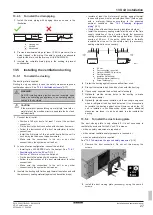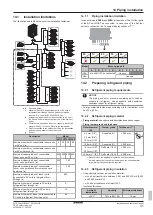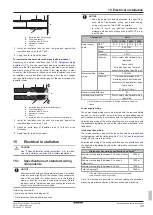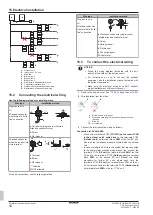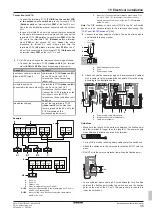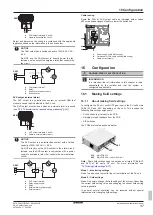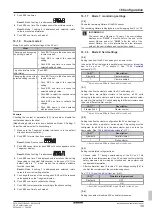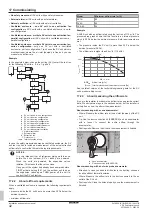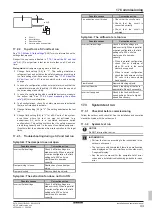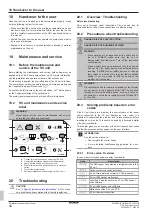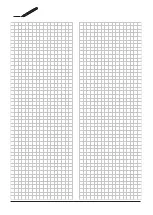
17 Commissioning
Installation and operation manual
41
SV1ASV4~8A14AJV1B
VRV 5 safety valve unit
4P709466-1 – 2023.09
[2-10]
Setting to enable or disable the external alarm output during the SV
unit test run.
This setting is only to be used during the test run of the SV unit when
a ventilated enclosure is used as a safety measure of the SV unit
and an external alarm is added as an additional measure. During the
SV unit test run, which is started by setting [2-3] to "1", the external
fan and external alarm are both active. To disable the external alarm
during the airflow rate measurements, change setting [2-10] to "1".
Once the SV unit test run is finished (setting [2-3] changed to "0"),
setting [2-10] automatically returns to its default value "0".
[2-10]
(a)
External alarm output forced OFF
0 (default)
Disable
1
Enable
(a)
Set ONLY on the LEFTMOST main PCB (A1P) of the SV unit.
16.1.9
Mode 2: default field settings
The table below shows the default field settings for A1P and A2P
(A2P only for SV6A and SV8A).
In case of wrong field settings made during the configuration
process, it is recommended to revert to the default field settings and
then restart the configuration.
Field setting
Description
Value
A1P
A2P
[2-0]
SV unit clustering
0
0
[2-1]
SV unit cluster number
0
0
[2-2]
SV unit cluster configuration
0
0
[2-3]
Simulate refrigerant leak
0
0
[2-4]
SV unit safety measures
1
0
[2-6]
Completion of commissioning check
0
1
[2-7]
Ventilated enclosure safety measure
1
0
[2-8]
Address value to SV unit for
supervisor remote controller
0
0
[2-9]
Address value to SV unit for error
handling
0
0
[2-10]
External alarm output during SV unit
test run
0
0
17
Commissioning
CAUTION
See
"2 Specific installer safety instructions"
4] to make
sure commissioning complies with all safety regulations.
NOTICE
General
commissioning
checklist.
Next
to
the
commissioning instructions in this chapter, a general
commissioning checklist is also available on the Daikin
Business Portal (authentication required).
The general commissioning checklist is complementary to
the instructions in this chapter and can be used as a
guideline and reporting template during commissioning and
hand-over to the user.
17.1
Checklist before commissioning
1
After the installation of the unit, check the items listed below.
2
Close the unit.
3
Power up the unit.
You have read the complete installation and operation
instructions described in the
installer and user reference
guide
.
The SV
unit
is properly mounted.
The
field wiring
has been carried out according to the
instructions described in this document, according to the
wiring diagram and according to the applicable national
wiring legislation.
The
drain piping
is properly installed and insulated, and
drainage flows smoothly. Check for water leaks.
Possible consequence:
condensate water might drip.
There are NO
missing phases
or
reversed phases
.
The system is properly
earthed
and the earth terminals
are tightened.
The
fuses
or locally installed protection devices are
installed according to this document, and have NOT been
bypassed.
The
power supply voltage
matches the voltage on the
identification label of the unit.
There are NO
loose connections
or damaged electrical
components in the switch box.
In case no safety measures are required, the following
measures are correctly applied:
▪ No safety measures are attached.
▪ The correct field settings are made.
In case an external alarm is required, the following safety
measures are correctly applied:
▪ The external alarm is connected and powered.
▪ The correct field settings are made.
In case natural ventilation is required as safety measure,
the following safety measures are correctly applied:
▪ Partition between rooms for natural ventilation meets
the requirements.
▪ The correct field settings are made.
In case a ventilated enclosure is required, the following
safety measures are correctly applied:
▪ The ducting is properly installed and insulated.
▪ The extraction fan is connected and powered.
▪ The air inlet (damper) is not obstructed.
▪ The correct field settings are made.
Also follow the outdoor unit's checklist. See the installation
and operation manual delivered with the outdoor unit.
17.2
SV unit test run
17.2.1
About the SV unit test run
The SV unit test run has to be performed on all SV units in the
system, before the test run of the outdoor unit. The SV unit test run
has to confirm that the required safety measures are properly
installed. Even when no safety measures are required, it is
necessary to perform this SV unit test run and confirm the result,
because the test run of the outdoor unit checks this confirmation for
all SV units in the system.
Depending on the safety measure and the configuration of the SV
unit, it is required to perform the SV unit test run on a specific SV
unit of the system.
Note:
Do not perform a SV unit test run on more than one SV unit at
a time.
Summary of Contents for VRV 5
Page 47: ......

